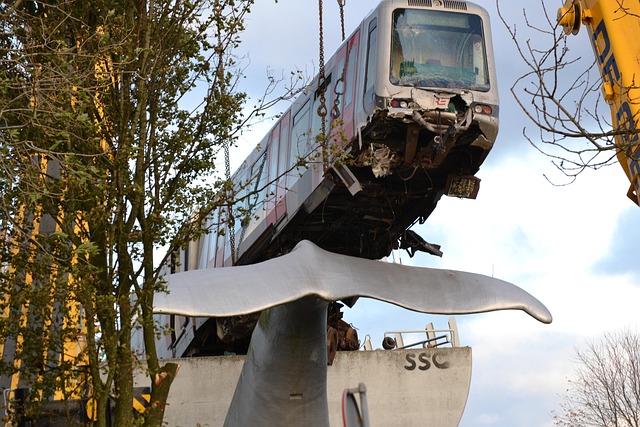Tractor Trailer Accidents & HazMat: Causes, Considerations, Mitigation

Tractor trailer accidents on national highways pose significant risks due to driver fatigue, operato…….
In the vast and intricate web of global transportation, tractor trailer accidents stand out as critical events with far-reaching consequences. These incidents, involving large commercial vehicles, often result in significant damage, injuries, and even fatalities, capturing the attention of policymakers, researchers, and the public alike. This article aims to delve into the multifaceted world of tractor trailer accidents, exploring their causes, impacts, and the various factors that shape their prevention and management. By examining historical perspectives, global trends, economic implications, technological innovations, policies, and real-world case studies, we will gain a comprehensive understanding of this complex phenomenon.
Definition: A tractor trailer accident refers to any mishap or collision involving a combination of a truck (or tractor) and one or more trailers designed for the transport of goods. These accidents can range from minor fender benders to catastrophic events, depending on various factors such as speed, weather conditions, vehicle maintenance, and driver behavior.
Core Components:
Historical Context:
Tractor trailer accidents have been a part of the trucking industry since its inception. As trucks evolved from simple horse-drawn carriages to modern motorized vehicles, so did the complexity of these incidents. Over time, advancements in technology and safety standards have aimed to reduce accident rates. However, the increasing volume of goods transported globally and the ever-growing size of trucks and trailers mean that understanding and mitigating risks associated with these accidents remains a critical challenge.
Significance:
Tractor trailer accidents are not confined to specific regions or countries; they occur worldwide, but their impact varies significantly across different parts of the globe. Several key trends shape the landscape of these incidents:
| Region | Freight Transportation Growth (%) | Average Annual Tractor Trailer Accidents (Estimated) |
|---|---|---|
| North America | 3.5 (2019-2021) | ~750,000 |
| Europe | 2.8 (2019-2021) | ~450,000 |
| Asia Pacific | 5.2 (2019-2021) | ~600,000 |
The economic aspects of tractor trailer accidents are multifaceted and significant, impacting both the trucking industry and the broader economy:
Technological innovations play a crucial role in enhancing road safety and reducing tractor trailer accidents:
Governments worldwide have implemented policies and regulations to address tractor trailer accidents, with varying degrees of success:
Despite significant progress in accident prevention, the tractor trailer industry faces several challenges and criticisms:
Actionable Solutions:
Case Study 1: Sweden’s Vision Zero Approach
Sweden has been at the forefront of road safety initiatives with its “Vision Zero” strategy, which aims to eliminate all traffic fatalities and severe injuries. This approach involves a holistic view of road safety, focusing on system-wide improvements rather than relying solely on individual driver responsibility. By implementing advanced transportation design, strict vehicle and driver regulations, and comprehensive public education, Sweden has achieved remarkable success:
Case Study 2: California’s Strict Trucking Regulations
California, the largest trucking state in the US, has implemented some of the most stringent trucking regulations, with positive outcomes:
Lessons Learned:
The future of tractor trailer accidents is shaped by emerging technologies, shifting global trends, and evolving regulatory landscapes:
Tractor trailer accidents are complex, multifaceted challenges that demand a comprehensive approach to safety. By examining historical contexts, global trends, economic considerations, technological advancements, policies, and real-world case studies, this article has provided valuable insights into the world of tractor trailer accidents. The path forward involves harnessing emerging technologies, fostering international collaboration, investing in infrastructure, and implementing strict but fair regulations.
As the trucking industry continues to evolve, so must our strategies for accident prevention. By learning from past successes and challenges, we can navigate a safer road ahead, ensuring that the movement of goods and people is accomplished with minimal risk and maximum efficiency. The future of tractor trailer accidents lies in the innovative application of technology, the collaborative efforts of stakeholders, and a relentless commitment to safety.
Q1: How do advanced driver assistance systems (ADAS) help prevent accidents?
A1: ADAS uses sensors, cameras, and radar to monitor the vehicle’s surroundings and provide drivers with real-time warnings. Features like adaptive cruise control maintain a safe following distance, lane departure warning alerts drivers when they drift from their lane, and collision avoidance systems can automatically apply brakes to prevent or mitigate collisions.
Q2: What are some common challenges in implementing strict driver training programs?
A2: Challenges include limited resources for training, especially in developing regions, resistance to change from industry veterans, and ensuring that training programs remain current with evolving technologies and regulations. Regular updates and industry collaboration can help overcome these hurdles.
Q3: How does technology like telematics contribute to accident prevention?
A3: Telematics devices track vehicle performance, driver behavior, and route efficiency, providing valuable data for carriers. This information enables companies to optimize routes, maintain vehicles, and train drivers more effectively. Advanced analytics can identify risky behaviors or patterns, allowing companies to take corrective actions.
Q4: What role does public awareness play in reducing tractor trailer accidents?
A4: Public education campaigns raise awareness about safe driving practices, hazard recognition, and the consequences of distracted or fatigued driving. Informed drivers are better equipped to make quick decisions, anticipate hazards, and maintain safe distances, contributing to overall accident reduction.

Tractor trailer accidents on national highways pose significant risks due to driver fatigue, operato…….

Tractor trailer accidents have significant insurance implications due to their complex dynamics. The…….

Tractor trailer accidents pose significant risks due to potential severe injuries and property damag…….

Tractor trailer accidents pose significant risks to pedestrians due to large size and weight of vehi…….

Tractor trailer accidents, particularly jackknifing, are complex dynamics requiring understanding of…….

In a tractor trailer accident, swift and structured actions are vital. Promptly notify emergency ser…….

After a tractor trailer accident, prioritize safety, seek immediate medical care, and document the s…….

Tractor trailer accidents pose severe risks due to their size and impact on smaller vehicles. Key ca…….

Tractor trailer accidents cause severe damage, injuries, or fatalities due to their size and weight……..

Tractor trailer accidents pose significant risks due to their large size and weight, often causing p…….